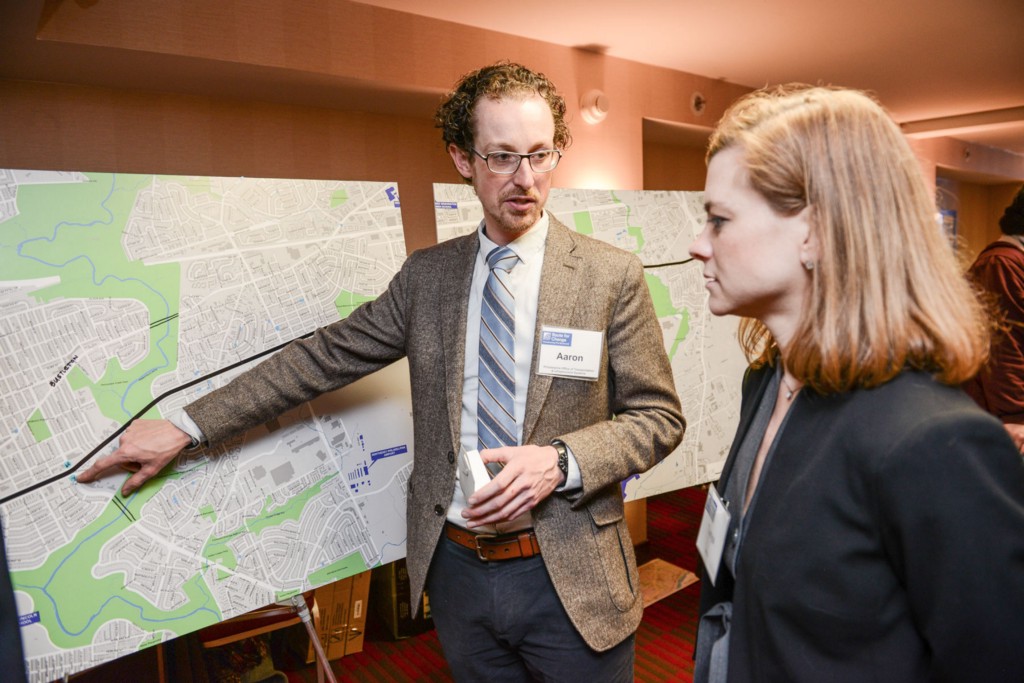MARIA YOUNG / TIMES PHOTO
The City of Philadelphia’s newly reorganized and renamed Office of Transportation and Infrastructure Systems, aka OTIS, was just one day into a three-year, $5 million project to study and make recommendations for improving Roosevelt Boulevard.
But two facts became abundantly clear at the program’s first public forum on April 14: a lot more people were interested in the project than OTIS expected and, next time, OTIS is going to need a bigger room.
After 30 minutes of the two-hour, open house-style introductory meeting, about 60 visitors had signed the registry at the door of a conference room at the Four Points by Sheraton-Northeast. Conversations were loud at about a half-dozen information stations packed into the meeting space as folks struggled to hear and be heard. In a rear corner of the room, there were about 15 chairs set up in front of a screen for a PowerPoint presentation. Angie Dixon, the energetic project manager from OTIS, spoke loudly as she attempted to introduce the audio-video loop over the din, but it was all in vain for many involved.
“I thought there was going to be a presentation, but you can’t hear a thing,” said Pat Tyson of Bustleton. “I’m not getting anything out of it and I think more people came to hear a presentation. Maybe people are just staying for the food and refreshments. I’m confused.”
“It’s really loud,” said Michael Noda of Francisville. “They should’ve gotten a bigger room.”
Dixon and her team viewed the response as a good thing, despite the first-night glitches.
“We’re very excited by the turnout,” she said. “I would like a bigger room. This is proof that there’s an overwhelming amount of interest.”
OTIS is the successor agency to the Mayor’s Office of Transportation and Utilities, which former Mayor Michael Nutter created during his first weeks in office. OTIS coordinates planning among the Streets Department, Commerce Department, City Planning, Parks and Recreation, SEPTA, the Pennsylvania Department of Transportation and other public agencies to improve transportation and make it more cost-efficient.
In September 2014, the Obama administration awarded the city a $2.5 million USDOT TIGER planning grant to fund a study of the Boulevard. The city, SEPTA and PennDOT are teaming to match the grant. The real work began on April 14 and at four more public forums over the ensuing week. The meetings were strategically located along the 14-mile study area, spanning from Broad Street to Neshaminy Mall in Bensalem Township, just outside the city.
OTIS sought public observations of existing conditions. At one information station, visitors to the meetings were asked about why and how they use the Boulevard — that is, where they like to go and what types of transportation they use to get there. At another station, they were asked their opinions about public transit; and at another, “safety, accessibility and reliability.”
Visitors were asked to plot their homes on wall-size maps of the Boulevard using colored stickers. But due to the large scale of the study area, many sections of the Northeast didn’t make the map, leaving some local denizens with no place to affix a sticker.
Noda has a keen interest in the project, although the North Philly neighborhood where he lives is about four miles from Broad and the Boulevard.
“I try to avoid Roosevelt Boulevard because of how unpleasant it is and I don’t like doing that because I feel cut off from a third of the city,” he said.
“I’d like to hear what the people have to say,” said Lorraine Brill, leader of the Upper Northwood Community Council. “I talked to some (OTIS) people who said what they’re not going to change.”
“I want to see the insurance data. They say accidents are affecting my insurance bill,” said Charlie Coyne of Mayfair. “I want to see who’s having all these accidents.”
Dixon said that OTIS will present three more series of forums over the next three years, followed by two open houses to share the project’s recommended improvements. That document will be a wishlist of sorts, but it will not formally trigger any actual changes. Future meeting dates have not been announced. ••

A route for change: Aaron Ritz (left), with the Office of Transportation and Infrastructure Systems, and Tanya Flint, with SEPTA, observe a map of Northeast Philadelphia during an introductory meeting to study and make recommendations for improving Roosevelt Boulevard on April 14. MARIA YOUNG / TIMES PHOTO





